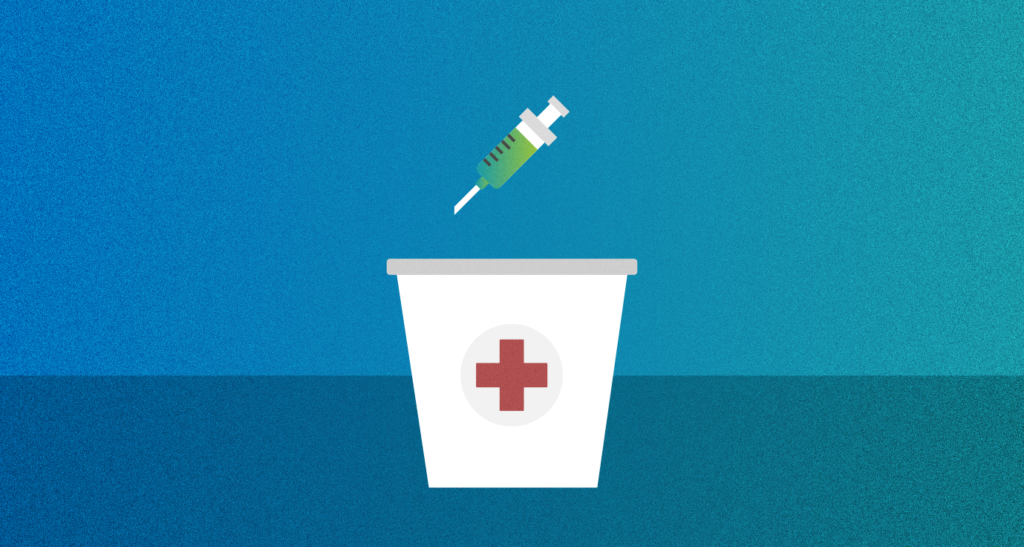Healthcare facilities are an important part of our society, and it’s hard to imagine a world without them. However, while saving lives and restoring hopes, hospitals, like any other facility, end up leaving a footprint behind. Statistics show that the U.S healthcare industry accounts for nearly 8.5 percent of the total carbon footprint emissions produced by the country.
Regardless of its size, every hospital struggles with waste management. Let’s face it. Hospital waste streams are not just large but also complex. On top of that, it’s not easy to run a facility where everything needs to be top-notch in terms of care, hygiene, and overall quality at all times.
In this article, we will discuss why healthcare facilities have difficulty achieving zero waste and how they can start their zero waste journey.
Types of Healthcare Waste
General Medical Waste
General medical waste is non-hazardous waste. What’s interesting to note about healthcare waste is that only a small percentage of it is hazardous. WHO reports that only 15 percent of the waste generated by healthcare activities is hazardous. The remaining 85 percent of the healthcare waste is generally non-hazardous.
Infectious Medical Waste
This waste poses a great threat to humans, animals, and the environment. It is contaminated with blood and sample waste from patients and laboratories, which may contain infectious diseases.
Hazardous Medical Waste
Hazardous medical waste is dangerous and can cause serious harm. It includes needles, sharps, blades, various chemicals, and solvents.

How is Healthcare Waste Usually Managed?
Incineration
The oldest and most common method for healthcare waste management is incineration — the controlled burning of waste. The process generally involves burning organic waste at a very high temperature. This generates certain gases such as carbon dioxide and toxic chemicals.
Chemical Disinfection
Chemical disinfection treats liquid waste such as blood, urine, and stool. It also kills microorganisms from medical equipment, floor, and walls. The added chemical kills or inactivates the pathogens.
Land Disposal
Land disposal is strictly waste disposal, not a waste treatment method. There are generally two types of land disposal:
- Sanitary landfills are designed to dispose of hazardous waste. They’re designed to prevent contamination of soil and surface and groundwater.
- Open dumps are unmanaged places where waste is usually scattered, leading to further transmission of infection.
Autoclaving
Autoclaving is the process of treatment in a pressurized state. This method uses an autoclave and is generally used to sterilize reusable medical equipment.
Encapsulation
Encapsulation is the method of disposing of sharps and chemical and pharmaceutical waste. In this process, high-density polyethylene or metallic drums are partially filled with waste, and the remaining portion is filled with mortar, dried, and sealed before disposal. The goal is to reduce the risk of scavengers or stray animals getting their hands on hazardous healthcare waste.
Inertization
The process of mixing healthcare waste with cement and other substances before disposal is called inertization. It’s suitable for pharmaceuticals and incineration ashes with high metal content. Although, inertization is an expensive and not generally recommended process.

Factors Impacting Hospital Zero Waste Journey
Unused Medical Supplies
In hospitals, unused medical equipment such as syringes and thermometers are discarded every minute. A study published by the Journal of Neurosurgery reports that about $968 of medical supplies are wasted in an average neurosurgical OR per procedure. Another study found that within 24 hours, the ER at the Massachusetts General Hospital threw away nearly 200 unused items.
While it may be important to discard some items, hospitals should regard what should and shouldn’t throw away. Reducing the disposal of unused medical supplies can be beneficial for both the hospitals and the environment.
Improper Disposal
A report published by the Massachusetts general hospital found that 85 percent of the waste thrown into the Red Bags was not regulated medical waste (RMW) — waste generated during research, production, and testing of biological or healthcare. Improper disposal of items in the RMW is a great threat to the environment. Every year, these improperly disposed items can cost hundreds of thousands in hauling fees and fines. On the other hand, hospitals can save a significant amount of money if they start sorting their waste properly.
Food Waste
While hospitals produce a lot of medical waste, you may be surprised to know that about 10 to 15 percent of the solid waste generate by hospitals is food waste. The U.S. Department of Agriculture reports that about 40 percent of the food supply in the United States is wasted, only 4 percent of which is composed. The remaining food waste usually ends up in landfills where it generates methane (a greenhouse gas) that traps 20 times more heat than carbon dioxide.
The best way to utilize the food wasted by healthcare facilities is by redirecting through donation, recycling, or composting. That way, less food goes to the landfills (or is incinerated) and fewer waste disposal trips.
Difficult to Reuse, Repurposed, or Donate Medical Waste
The disposal of bulky and hard-to-recycle items such as large medical devices and lab equipment can be a challenge. Since a lot of medical devices are electronic, a variety of different materials are used, which makes it extremely difficult to recycle.
Many hospitals address this issue by using single-use medical equipment. However, hospitals that are committed to the zero waste goal must opt for products that can be reused or upcycled. Additionally, donating medical equipment can be tricky, but many organizations will accept and distribute gently-used medical equipment to medical teams worldwide.

How are Hospitals Starting their Zero Waste Journey?
In large public facilities, improper sorting and excessive contamination are the biggest challenges to starting a zero waste journey. While material recovery facilities use technology, achieving zero waste goals depends heavily on proper sorting at the time of disposal. This is because recycling rules are not only complex, but they vary from place to place, which leads to confusion among users.
Starting a recycling program can be tricky for a hospital that hundreds or thousands of people visit daily. Smart waste bins like TrashBot can make it easier to start your zero waste journey by sorting waste at the time of disposal. TrashBot also features an analytics dashboard, on-demand waste audits, a built-in screen, and a content management system.
TrashBot was piloted at a Los Angeles hospital, where it impacted over 240,000 visitors during the 3-month performance period. Following are the results of the three-month pilot program:
- Reduced contamination in the recycling and compost streams by 95%
- 300% more accurate sorting compared to conventional trash receptacles
- Diversion rates of the hospital increased by 50% by using Trashbot’s data to find the top 5 landfill items and replacing them with compostables
- Custom educational content was exhibited on TrashBot

